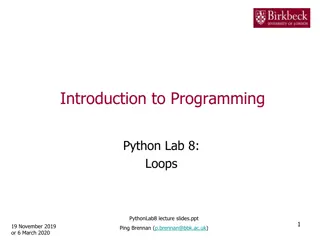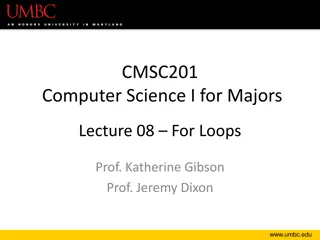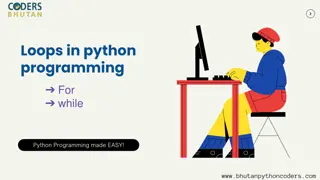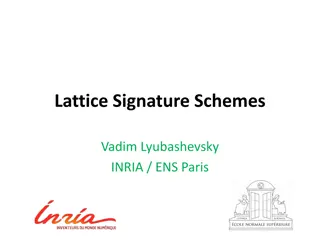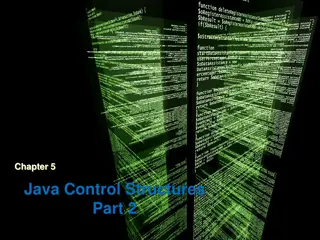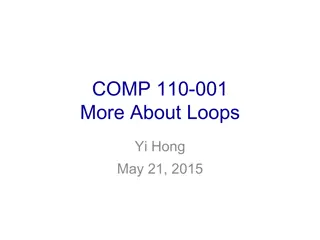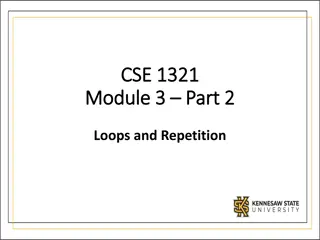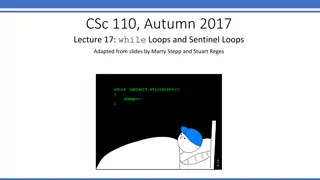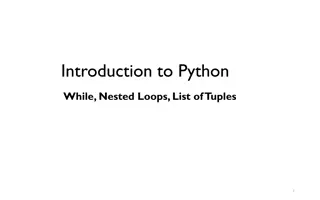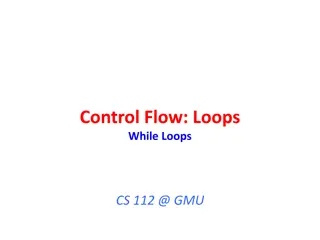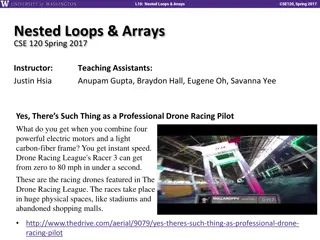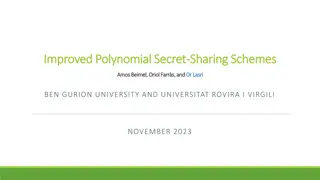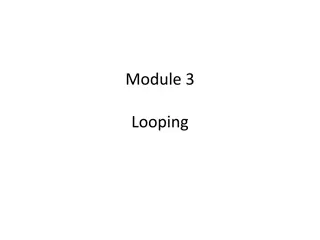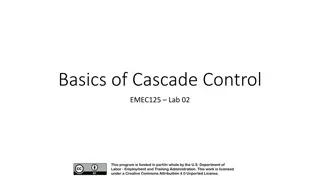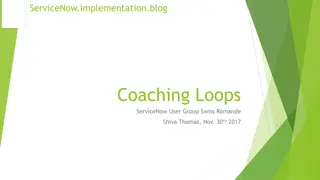Process Control Loops & Control Schemes
This content delves into types of process control loops including feedback, feedforward, ratio, cascade, and split range control schemes. It explains feedback control in detail, its advantages, disadvantages, and provides examples. Furthermore, it covers constructing feedback control loops for different systems and the concept of feedforward control in control systems.
Uploaded on Mar 03, 2025 | 0 Views
Download Presentation

Please find below an Image/Link to download the presentation.
The content on the website is provided AS IS for your information and personal use only. It may not be sold, licensed, or shared on other websites without obtaining consent from the author.If you encounter any issues during the download, it is possible that the publisher has removed the file from their server.
You are allowed to download the files provided on this website for personal or commercial use, subject to the condition that they are used lawfully. All files are the property of their respective owners.
The content on the website is provided AS IS for your information and personal use only. It may not be sold, licensed, or shared on other websites without obtaining consent from the author.
E N D
Presentation Transcript
Process Control Course II Lecture 12 Process Control Loops Part II By Prof. Alaa Kareem Mohammed 1
Type of Process Control Loop 1- Feedback Control 2- Feedforward Control 3- Feedforward-plus-Feedback Control 4- Ratio Control 5- Cascade Control 6- Split Range Control 2
1- Feedback Control Process: Heating tank CSTH ??= ?(?,??,?) Controlled variable : To Manipulating variable: Q: TI Set point TRC T T m Ti T E m ,To M Steam in Q
A feedback loop measures a process variable and sends the measurement to a controller for comparison to set point. If the process variable is not at set point, control action is taken to return the process variable to set point. This control scheme does not take into consideration any of the other variables in the process Advantages : 1- One of the simplest process control schemes. 2- It is commonly used in the process control industry. 3- It is that directly controls the desired process variable Disadvantage : The disadvantage of feedback loops is that it takes some time in order that the controlled variable reaches the set point. 4
Example 1 Consider the liquid level tank shown below. Draw a feedback control loop to control the liquid level inside the tank (h). The control loop should contains the following : 1- Measuring element ?? 2- Transmitter. 3- Indicator (function in DCS) 4- Recording controlling (front mounted in remote panel) 5- Pneumatic control valve. h ? ?? 6- Give tag No. for these items 5
Solution LT LI LRC Set point 41201 41201 41201 ?? LE 41201 h ? ?? 6
Homework 1 Consider the heating tank system below. Construct two feedback control loops on the system according to the following description: First control loop: Controlled variable : To Manipulating variable : Q m Ti Second control loop: Controlled variable : h Manipulating variable : m h m ,To Steam in Q 7
2- Feedforward Control Feedforward loop is a control system that anticipates load disturbances and controls them before they can impact the process variable. For feedforward control to work, the user must have a mathematical understanding of how the manipulated variables will impact the process variable. m Ti For the heating tank shown beside, we notice that ??= ?(?,?,??) ? ?? ???????????? ???????? h m ,To ?? ??? ? ??? ???? ???????? In feedforward control, the controlled variable will be controlled through the load variables only Steam in Q 8
FIC Set point F T F E m Ti T E Set point h m ,To T T TIC Steam in Q 9
An advantage of feedforward control is that error is prevented, rather than corrected. Feedforward scheme is better than feedback control scheme in that it takes no time to manipulate the controlled variable when the system is subjected to a disturbance. The difficulty that face the feedforward loop is that it should take into account all the possible load disturbances in a system , but this is either difficult or costly. 10
Example 2 Consider the liquid level tank shown below. Draw a feedforward control loop to control the liquid level inside the tank (h). Knowing that = ?(??). The control loop should contains the following : 1- Measuring element 2- Transmitter. ?? 3- Indicator rear mounted on local panel. 4- Recording controlling (field mounted) 5- Pneumatic control valve. h ? ?? 11
Solution FI FT = ?( ??) FRC Set point FE ?? h ? ?? 12
Example 3 Base tank The diagram below shows pH adjustment. TK-101 NaOH We want to keep the solution in the tank TK-100 at pH=7. The pH of the inlet solution is 5. the adjustment is carried out by addition base NaOH. As shown in diagram beside . F2 ??2= ?(?1,?2) F1 1- Draw feedforward control loop to control outlet pH at 7 Inlet solution 2- Repeat (1) using feedback loop only. pH1 TK-100 F3 outlet solution pH2 pH adjustment tank 13
Base tank Solution Set point 1 - Feedforward loop TK-101 NaOH ??2= ?(?1,?2) F IC F T F2 is manipulating variable F1 is load variable F E F2 F1 Inlet solution pH1=5 TK-100 F3 outlet solution pH2 pH adjustment tank 14
Base tank - Feedback loop TK-101 NaOH F2 pH IC Set point F1 pH T Inlet solution pH1=5 pH E TK-100 F3 outlet solution pH2 15
3- Feedforward-plus-Feedback Control It is a combined system which consists of two loops feedforward and feedback loops. It is used when the controlled variable is function of many variables, so it is difficult to take account for every possible load disturbance. Feedforward is used for the load disturbance which has great effect on controlled variable. Feedback loop is used for controlled variable. Controller with summing functions are used in these combined systems to total the input from both the feedforward loop and the feedback loop, and send a unified signal to the final control element. 16
Example 4 Consider the heating vessel below . The temperature of the outlet stream T3 is function of many variables m2 T2 m1 T1 ?3= ?(?1,?2,?,?1,?2) Inlet flowrate m1 is more effective on the controlled variable T3 Use feedforward pulse - feedback loop to control the temperature of outlet stream T3. h m3 T3 Steam in Q 17
Solution Set point FIC F T F E m2 T2 m1,T1 m3 ,T3 Set point Steam in T E Q TIC T T 18
Another solution FIC F T Set point Set point TIC F E m2 T2 T T m1,T1 T E m3 ,T3 Steam in Q 19
Homework 2 Two liquid level tanks are connected in series as shown in Fig. beside. The liquid level in the second tank h2 is to be controlled. 2= ?( ??,?3,?4) q3 qo h1 q4 q1 Construct control loop to control h2 using: 1- Feedforward loop 2- Feedback loop 3- Feedforward-plus-feedback. R1 TK101 q2 h2 R2 TK102 20
4- Ratio Control This unit multiplies (B) by the desired ratio; so the output=? ? Ratio control is used to ensure that two or ? = ? more flows are kept at the same ratio even if the flows are changing. A B F T FIC F Y F T Suppose that the required ratio ? ?=1 2 F E F E The function of FY is to multiply Ratio set point the output of FT by the required ratio ? ? ? ? Water Acid The result is A , this result is used as the set point to the controller FC 2 parts of water 1 part of acid 21
Ratio control is applied in the following cases : 1- Blending two or more flows to produce a mixture with specified composition 2- Blending two or more flows to produce a mixture with specified physical properties. 3- Maintaining correct air and fuel mixture to combustion. If the physical characteristic of the mixed flow is measured, a PID controller can be used to manipulate the ratio value For example, a measurement of the density, gasoline octane rating, color, or other characteristic could be used to control that characteristic by manipulating the ratio. 22
Example 5 Overhead vapor Use ratio control loop to control the flow of product (P) and the flow of the reflex (R) that outlet from the overhead drum of a distillation column. The ratio ? ? is fixed. Overhead drum Product Reflex to column R P 23
Overhead vapor Solution Condenser Overhead drum Product P R Reflex to column Ratio set point FE F E FT FY FT FIC 24
Ratio control for three streams Suppose we have three streams A,B and C as shown in Figure below. The ratio of these streams are A:B:C= 1:2:10. Draw a control loop to adjust the mixed stream at the given ratio. FT FIC F E A FT FE FIC R B Mixer Ratio set point ? FY2 ? A:B:C = 1:2:10 Ratio set point F E FT FY1 ? ? C 25
Homework 3 Use the Ratio control loop to adjust the ratio of fuel that inlet to the furnace as shown in Figure below. A Air Furnace mixer B Fuel 26
5- Cascade Control Temperature controller primary Flow controller secondary Cascade control consists of two loops ; primary Steam mi, ti loop and secondary loop. Set point Primary loop is constructed on the variable to be T C F T FIC controlled while the secondary loop is constructed on the manipulating variable. T T Consider the shell and tube heat exchanger in Fig. beside. Suppose we want to control T E the outlet temperature T2 at a certain value by manipulating variable mi using cascade Fluid out T2 Fluid in T1 control. mo , to 27
Requirements for cascade control: - Secondary loop process dynamics must be at least four times as fast as primary loop process dynamics. - Secondary loop must have influence over the primary loop. - Secondary loop must be measured and controllable. 28
Example 6 Use cascade loop to control the level of the liquid inside the Tank in Figure below. Knowing that = ?( ?1,?2). Use ?2 as manipulating variable. Repeat the solution if we use feedback loop only. ?1 ?2 h 29
Solution Cascade control loop Set point LRC LI LT ?1 FT FIC LE F E ?2 h 30
Feedback control loop Set point LRC LI LT ?1 LE ?2 h 31
Homework 3 Figure below shows a jacketed reactor which carries out exothermic reaction. Reactants We want to control the reaction temperature T . The manipulating variable is the flowrate of the cooling water to the jacket(m). T 1- use cascade control loop only Reactor Cooling water m kg/s 2- use feedback control loop only Product 3- use feedforward pulse- feedback loop. 32
5- Split Range Control Spilt control loop is very common control scheme in which the output of a controller is split to two or more of control valves. In this case , one of the control valve is chosen normally closed and the other is chosen normally open. For example (Figure below) FIC FT Valve A Controller output 0% Valve A fully open and valve B fully closed Valve B Controller output 25% Valve A is 75% open and valve B is 25% open Controller output 50 % Valve A is 50 % open and valve B is 50 % open Controller output 75 % Valve A is 25 % open and valve B is 75 % open Controller output 100 % Valve A is fully closed and valve B is fully open 33
Example 7 Base tank Acid tank The diagram below shows pH adjustment. TK-101 H2SO4 TK-102 NaOH We want to keep the solution in the tank TK-100 at pH=6. Use split range control loop to adjust the value of pH in the tank at 6 with the aid of the acid and base feeding tanks. F1 Inlet solution TK-100 F2 outlet solution (pH adjustment tank) 34
Solution Base tank Acid tank TK-101 H2SO4 TK-102 NaOH F1 Inlet solution pHC Set point TK-100 pHI pHT pHE F2 outlet solution (pH adjustment tank) 35
Homework 4 Use split range control loop to control the pressure inside the overhead accumulator (shown below). When the pressure exceed the desired value , the line to flare will open so the outlet stream is divided into two stream ;one to flare and the other to process unit. Flare Overhead vapor Process unit P Reflex to column Overhead accumulator 36
Reward (2 marks) Figure below shows a reactor for detergent production. The inlet liquids are in the ratio of A : B: C= 1: 3: 20 Construct a control system that consists of different loops to control the following output variables: 1- The liquid level inside the reactor (h) 2- The temperature (T) of the reaction mixture. 3- Keep the ratio of inlet feeds constant. A Sulfonic acid Water B C NaOH Cooling water out T h Reactor Product (detergent) Cooling water in 37
Ratio set point ? ? FRC FE FY1 FI A FT Sulfonic acid FY2 FE Ratio set point ? FRC FE C Water FI ? B NaOH Set point LIC LT LE Set point T h TRC TE TI Cooling water out Reactor Cooling water in Product (detergent)
M (kg/h) condenser LE LT Distillation column LRC set point Overhead drum h1 R (kg/h) 1 Feed, F TF 2 P (kg/h) FE FE FRC FT FT FY 6 w (kg/h) set point TIC TT TE Ratio set point ? ? S (kg/h) N (kg/h) h2 B (kg/h) Feed, F B (kg/h) LE LRC LT set point 39
Ratio set point ? FY1 ? Ratio set point ? ? FRC FI FY2 FT FE Water FE A NaOH B FRC FE FE C Sulfonic acid LIC LE LT Set point Cooling water out T h pHC pHT pHE Reactor Product (detergent) Set point pH Cooling water in TE TIC TI Set point 40
Thank you Any ? 41


